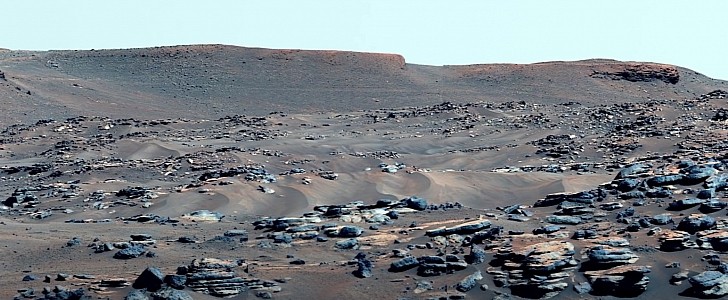It was less than a year ago when the Perseverance rover landed in the Jezero Crater on Mars, and already the little machine is part of the history books, as it helped NASA fly, for the first time, a helicopter on another world. As far as actual discoveries go, achievements have so far been modest, to say the least.
Well, they were not actually modest, but were rather slow to unravel themselves. Until this week, that is, when the team that handles the machine decided to give us a taste of findings that may be instrumental to the success of future missions to Mars, and our understanding of the planet.
As said, the rover landed in the Jezero Crater, a formation 45 km (28 miles) in diameter that was thought to have once been filled with water. “Was thought,” because now, thanks to Perseverance, we humans know for sure that it was.
The first discovery shared with the public is that “the bedrock the six-wheeled explorer has been driving on since landing in February likely formed from red-hot magma.” We’re not told how that came to be, as several options are currently being taken under consideration, including the existence of an extinct volcano in the area.
Then, in the dust on non-abraded rock in the area, Perseverance found signs the crater “interacted with water multiple times over the eons.” More importantly, it also contains organic molecules.
Now, before getting all worked up, know that organic molecules don’t necessarily mean “that life once existed in Jezero,” as they can come to be through both biological and non-biological mechanisms.
Scientists will be using the data from Perseverance and the fancy instruments on the rover to “understand the environment in which the organics formed,” and only those findings will shed light on the possible existence of life on Mars.
The video below, made with still taken by the rover's Mastcam-Z instrument, was released along with these findings, and shows the delta at Jezero, as seen second through enhanced-color. Full details on the findings can be found at this link.
As said, the rover landed in the Jezero Crater, a formation 45 km (28 miles) in diameter that was thought to have once been filled with water. “Was thought,” because now, thanks to Perseverance, we humans know for sure that it was.
The first discovery shared with the public is that “the bedrock the six-wheeled explorer has been driving on since landing in February likely formed from red-hot magma.” We’re not told how that came to be, as several options are currently being taken under consideration, including the existence of an extinct volcano in the area.
Then, in the dust on non-abraded rock in the area, Perseverance found signs the crater “interacted with water multiple times over the eons.” More importantly, it also contains organic molecules.
Now, before getting all worked up, know that organic molecules don’t necessarily mean “that life once existed in Jezero,” as they can come to be through both biological and non-biological mechanisms.
Scientists will be using the data from Perseverance and the fancy instruments on the rover to “understand the environment in which the organics formed,” and only those findings will shed light on the possible existence of life on Mars.
The video below, made with still taken by the rover's Mastcam-Z instrument, was released along with these findings, and shows the delta at Jezero, as seen second through enhanced-color. Full details on the findings can be found at this link.











